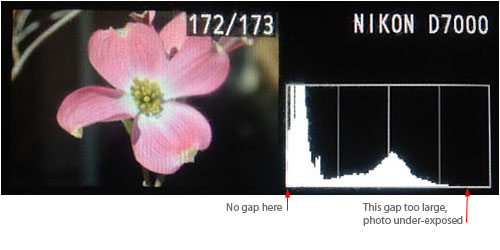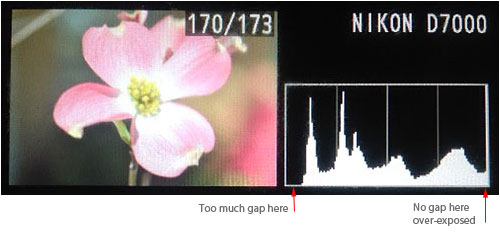Photographing Australian Plants
Exposure — some thoughts for flower photography
Most people these days will be using digital cameras, so I will confine my comments on exposure to these cameras.
Trying to judge whether your photo is correctly exposed when you are out in the field with the sun levels changing is very difficult, the image displayed at the back of the camera looks very different if you are in the shade or in full sun and analysis is further hampered by reflections.
Digital cameras usually display a histogram showing the distribution of light values for the photo.
This is a much more reliable method to check the exposure of the photo you have just taken than just looking at it on the camera's screen.
Below are examples from a Nikon D7000 camera, but most cameras have similar displays, even pocket point-and-shoot cameras.
The nice thing with plant photography is that the plant usually doesn't move, if the first photo is incorrectly exposed you can take another until you get it right.
UnderexposedThe 'box' shows what the camera has recorded. The histogram shows that there is information on the left that has not been captured by the camera. This is the detail missing in the background. |
 |
Correctly exposedThe full range of exposure values is captured within the 'box', with a slight gap on the left and on the right. |
 |
OverexposedHere there is obviously some part of the exposure range for the photo that has been lost on the right-hand side of the 'box'. This information is missing, so it cannot be properly adjusted in an editing program later. (a matching RAW file might have more information for retrieval) |
 |
In a properly exposed photo, the whole curved outline of the histogram fits within the bounding 'box' displayed on the camera's rear screen.
If the histogram is cut off by the border on either side of the 'box', then some of the
information has not been captured by the camera.
Some exposure adjustment can be made in programs like Photoshop after the photo has been taken, but best results will be achieved is all the exposure information that could be captured by the camera has been captured.
In the top and bottom examples above, some information has not been captured, so editing programs have to 'make it up'.
More sophisticated cameras have a +/- button to change the exposure range captured when set to 'auto', in effect moving the boundary 'box' of the histogram to the left or the right so that missing bit of the histogram curve fits within the 'box'. If your camera is set to a manual mode, you can increase or decrease the exposure (change the f number).
When taking close-ups with flash, it is usually much easier to take several photos at different exposures and keep the one where the histogram curve fits completely within the 'box'.
If your histogram curve fits within the 'box', but with a lot of space at both ends, then your photo lacks contrast, usually it means it was taken in very dull lighting conditions. The camera has captured all the exposure information available, and later editing programs can often add contrast to retrieve the image, in effect spreading the histogram curve out to fill the 'box'.
![An Australian Government Initiative [logo]](/images/austgovt_brown_90px.gif)

